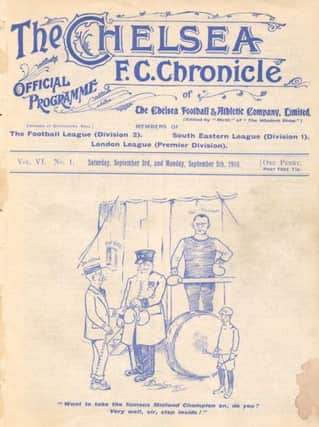Nostalgia / Ian Hine recalls Albion’s finest achievement against Aston Villa way back in 1910


This is our first meeting in this competition, but our first competitive fixture against Villa came in September, nearly 110 years ago.
We have been a Football League club since 1920 but before then, our time in the Southern League brought some notable successes. None more so than the events of 1910, culminating in one of the greatest days in the club’s history.
Advertisement
Hide AdAdvertisement
Hide AdThe 1909/10 season started with two draws, but the 4-1 win against Portsmouth at the start of September was to be the springboard for a memorable season. By the time Southampton knocked us out of the FA Cup in January 1910, we were challenging at the top of the Southern League table. An away win at Reading at the start of February sent us top, a position we did not give up for the remainder of the campaign. Albion finished five points clear of Swindon Town, who we beat in a thriller at The Goldstone in April 1910, in front of a then record crowd of 11,000.
The reward for the title win was a place in the Charity Shield. For five years from 1908, the Shield was contested by the champions of the Southern League and the Football League. We were to play Aston Villa on 5th September 1910, with the winners being crowned ‘Champions of All England’. The game was to take place at Stamford Bridge, at the time the most prestigious ground in the country.
The team travelled to London on the morning of the match, along with hundreds of fans decked out in blue and white. The players went on from Victoria station in a horse-drawn carriage to take on Villa who were one of the giants of English football at the time.
Manager Jack Robson was able to call on a very strong Albion line-up. Bob Whiting was in goal, hoping to bring some of his legendary kicking ability to bear on the game. His habit of launching the ball deep into the opposition half earned him the nickname of ‘Pom-Pom’, after the machine gun used in the Boer War.
Advertisement
Hide AdAdvertisement
Hide AdThe full-backs were skipper Joe Leeming and Fred Blackman, with the half-back line of Billy Booth, Joe McGhie and Jack Haworth completing what we would now describe as the defensive midfield. Centre-Forward Bill ‘Bullet’ Jones’ was just 5’ 5” tall but was a giant of a man, who had a 38-year association with the club. The inside-Forwards were Jimmy Coleman and Albion’s star player Charlie Webb. The players tasked with supplying balls from the wing were Bert Longstaff and Bill Hastings.
Albion had to be at their very best to compete with Aston Villa and right from the start, the Football League side put their opponents under pressure. Wave after wave of attacks were broken down by Leeming and Blackman, meaning Whiting had little to do for much of the game. When he was called upon, he was equal to the task, at one stage fisting a fierce shot from Wallace away from danger. Villa did have the ball in the back of the net midway through the first half. A corner from left winger Albert Hall sailed over the head of everyone and straight into the net. In those days, scoring direct from a corner was not allowed, so the goal was disallowed. Two great efforts from Webb and Jones followed before half-time, but the teams went in level at the break.
The Albion defence continued to offer fantastic protection to Whiting and as the game wore on, our forwards began to make inroads into the Villa defence. With 18 minutes left to play, Albion forced a corner and Longstaff again delivered with accuracy into the penalty area. Bill Hastings gathered the ball passed to Charlie Webb who evaded a couple of defenders before sending a rising cross-shot into the back of the net.
There was no further scoring and the final whistle was greeted with jubilation from the traveling supporters, who invaded the pitch at the end. After the presentation of the Shield, the team made their way back to Brighton, where they were welcomed by another huge crowd at the station.
Advertisement
Hide AdAdvertisement
Hide AdAlbion’s triumph was the only time the Southern League champions beat the Football League equivalent and the triumph remains one of the club’s greatest-ever achievements. The success was commemorated by a number of items of memorabilia, including postcards, cigarette cards and photographs.
Goalscorer Charlie Webb made 275 appearances for the club, scoring 79 goals, none more important than the one at Stamford Bridge 119 years ago. He went to manage the club and in his 38-year tenure, took charge of 1,215 games. He really was ‘Mr Albion’. He passed away aged 86 and a tree was planted in Hove Park to his memory by his daughter Joyce.